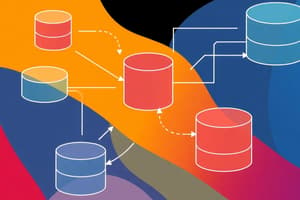Podcast
Questions and Answers
What is the primary purpose of a data model?
What is the primary purpose of a data model?
- To store large volumes of unstructured data
- To protect sensitive data from unauthorized access
- To visualize data structures and their relationships (correct)
- To create graphical user interfaces for databases
Which data model is most commonly used as a communication tool between database designers and end users?
Which data model is most commonly used as a communication tool between database designers and end users?
- Relational data model
- Object-based data model
- Entity-Relationship data model (correct)
- Semi-structured data model
What is included in the basic building blocks of data modeling?
What is included in the basic building blocks of data modeling?
- Cloud storage options and data encryption
- Networking protocols and hardware specifications
- Data structures and relationships (correct)
- Data types and user interfaces
Which of the following is NOT a level of abstraction in data models?
Which of the following is NOT a level of abstraction in data models?
Which data model combines both object-oriented and entity-relationship approaches?
Which data model combines both object-oriented and entity-relationship approaches?
What is evaluated to determine the relationship type between two entities in a business model?
What is evaluated to determine the relationship type between two entities in a business model?
In the example of students and classes, how many students can enroll in one class?
In the example of students and classes, how many students can enroll in one class?
What describes the relationship type between an agent and a customer according to the provided information?
What describes the relationship type between an agent and a customer according to the provided information?
What is the purpose of the two questions asked to assess relationships between entities?
What is the purpose of the two questions asked to assess relationships between entities?
Which of the following correctly describes the cardinality of the relationship between agents and customers?
Which of the following correctly describes the cardinality of the relationship between agents and customers?
Which of the following best defines an entity in a data model?
Which of the following best defines an entity in a data model?
What is the primary purpose of business rules in data modeling?
What is the primary purpose of business rules in data modeling?
Which of the following is NOT a source of business rules?
Which of the following is NOT a source of business rules?
Why is proper naming important in data modeling?
Why is proper naming important in data modeling?
Which of the following statements best describes a constraint in data modeling?
Which of the following statements best describes a constraint in data modeling?
What is one reason for identifying business rules?
What is one reason for identifying business rules?
In the context of data models, what is an example of a relationship?
In the context of data models, what is an example of a relationship?
Which statement accurately describes an agent entity?
Which statement accurately describes an agent entity?
What structure does the hierarchical database model represent?
What structure does the hierarchical database model represent?
Which relationship type is primarily promoted by the hierarchical database model?
Which relationship type is primarily promoted by the hierarchical database model?
What is a disadvantage of the hierarchical database model?
What is a disadvantage of the hierarchical database model?
Which type of relationships can the network model represent?
Which type of relationships can the network model represent?
What concept is defined by the data manipulation language (DML)?
What concept is defined by the data manipulation language (DML)?
Which of the following is NOT a characteristic of the network model?
Which of the following is NOT a characteristic of the network model?
What does schema data definition language (DDL) enable a database administrator to do?
What does schema data definition language (DDL) enable a database administrator to do?
Which advantage is associated with the hierarchical model?
Which advantage is associated with the hierarchical model?
What is a limitation of the hierarchical database model regarding application programs?
What is a limitation of the hierarchical database model regarding application programs?
Which of the following is true about the network model?
Which of the following is true about the network model?
What is a primary disadvantage of the network model in database management?
What is a primary disadvantage of the network model in database management?
Which of the following is a key feature of the relational model?
Which of the following is a key feature of the relational model?
What element in a relational database is essential for relating tables?
What element in a relational database is essential for relating tables?
What is one advantage of using the Entity Relationship (ER) model?
What is one advantage of using the Entity Relationship (ER) model?
Which of the following is a disadvantage of SQL-based relational databases?
Which of the following is a disadvantage of SQL-based relational databases?
What is the primary purpose of a SQL engine in a relational database system?
What is the primary purpose of a SQL engine in a relational database system?
What describes the term 'tuple' in the context of a relational model?
What describes the term 'tuple' in the context of a relational model?
Which of the following statements is true regarding the structural independence of relational databases?
Which of the following statements is true regarding the structural independence of relational databases?
Which data model evolved primarily to address the limitations of hierarchical and network DBMS systems?
Which data model evolved primarily to address the limitations of hierarchical and network DBMS systems?
What is a major limitation of the network data model?
What is a major limitation of the network data model?
What characterizes the Object-Oriented Data Model (OODM)?
What characterizes the Object-Oriented Data Model (OODM)?
Which of the following is a key disadvantage of the Object-Oriented Data Model?
Which of the following is a key disadvantage of the Object-Oriented Data Model?
What is one of the primary aims of NoSQL databases?
What is one of the primary aims of NoSQL databases?
What does the 'class hierarchy' in object-oriented data models resemble?
What does the 'class hierarchy' in object-oriented data models resemble?
Which data model best supports unstructured data management?
Which data model best supports unstructured data management?
What does the internal model primarily deal with?
What does the internal model primarily deal with?
What is a significant advantage of using the Extended Relational Data Model (ERDM)?
What is a significant advantage of using the Extended Relational Data Model (ERDM)?
Which statement about the advantages of UML in data modeling is true?
Which statement about the advantages of UML in data modeling is true?
What is one of the characteristics of NoSQL databases?
What is one of the characteristics of NoSQL databases?
Which model operates at the lowest level of data abstraction?
Which model operates at the lowest level of data abstraction?
What issue does 'velocity' refer to in the context of NoSQL databases?
What issue does 'velocity' refer to in the context of NoSQL databases?
What results from the limitation of constraint representation in ER models?
What results from the limitation of constraint representation in ER models?
Which of the following best describes the external model in data modeling?
Which of the following best describes the external model in data modeling?
Flashcards
Data Model
Data Model
A representation of data structures, relationships, constraints, transformations, and other constructs used to support a specific problem domain.
Relational Data Model
Relational Data Model
A data model that stores data in tables, representing data and their relationships using a table format.
Entity-Relationship Data Model (E-R Model)
Entity-Relationship Data Model (E-R Model)
A popular communication tool between database designers and end-users, representing entities and their relationships.
Object-Based Data Model
Object-Based Data Model
Signup and view all the flashcards
Semi-Structured Data Model
Semi-Structured Data Model
Signup and view all the flashcards
Relationship Cardinality
Relationship Cardinality
Signup and view all the flashcards
1:M Relationship
1:M Relationship
Signup and view all the flashcards
M:M Relationship
M:M Relationship
Signup and view all the flashcards
Cardinality Assessment
Cardinality Assessment
Signup and view all the flashcards
Entity
Entity
Signup and view all the flashcards
Agent entity
Agent entity
Signup and view all the flashcards
Business Rule
Business Rule
Signup and view all the flashcards
Relationship
Relationship
Signup and view all the flashcards
Constraint
Constraint
Signup and view all the flashcards
Data Model
Data Model
Signup and view all the flashcards
Attribute
Attribute
Signup and view all the flashcards
Naming Conventions
Naming Conventions
Signup and view all the flashcards
Hierarchical Database Model
Hierarchical Database Model
Signup and view all the flashcards
Hierarchical Database Model - Advantages
Hierarchical Database Model - Advantages
Signup and view all the flashcards
Hierarchical Database Model - Disadvantages
Hierarchical Database Model - Disadvantages
Signup and view all the flashcards
Network Database Model
Network Database Model
Signup and view all the flashcards
Network Database Model - Uses
Network Database Model - Uses
Signup and view all the flashcards
Network Model
Network Model
Signup and view all the flashcards
Data Manipulation Language (DML)
Data Manipulation Language (DML)
Signup and view all the flashcards
Relational Model
Relational Model
Signup and view all the flashcards
Schema Data Definition Language (DDL)
Schema Data Definition Language (DDL)
Signup and view all the flashcards
Relational Database Management System (RDBMS)
Relational Database Management System (RDBMS)
Signup and view all the flashcards
Relationships (in Relational Model)
Relationships (in Relational Model)
Signup and view all the flashcards
SQL
SQL
Signup and view all the flashcards
Entity-Relationship (ER) Model
Entity-Relationship (ER) Model
Signup and view all the flashcards
Entity (in ER Model)
Entity (in ER Model)
Signup and view all the flashcards
Crow's Foot ERD
Crow's Foot ERD
Signup and view all the flashcards
Chen ERD
Chen ERD
Signup and view all the flashcards
ERD Advantages
ERD Advantages
Signup and view all the flashcards
ERD Disadvantages
ERD Disadvantages
Signup and view all the flashcards
Data Models Evolution
Data Models Evolution
Signup and view all the flashcards
Object-Oriented Data Model (OODM)
Object-Oriented Data Model (OODM)
Signup and view all the flashcards
OODM Class
OODM Class
Signup and view all the flashcards
OODM Class Hierarchy
OODM Class Hierarchy
Signup and view all the flashcards
OODM Inheritance
OODM Inheritance
Signup and view all the flashcards
External Model
External Model
Signup and view all the flashcards
Conceptual Model
Conceptual Model
Signup and view all the flashcards
Internal Model
Internal Model
Signup and view all the flashcards
Physical Model
Physical Model
Signup and view all the flashcards
NoSQL
NoSQL
Signup and view all the flashcards
Big Data Challenges
Big Data Challenges
Signup and view all the flashcards
Hadoop
Hadoop
Signup and view all the flashcards
Study Notes
Database Systems - Chapter 2: Data Models
- Data modeling is an iterative and progressive process for creating a specific data model for a determined problem domain.
- Data models are important for organizing data for various users, acting as a communication tool between designers and end users, and providing an overall view of the database.
- Data models represent data structures, characteristics, relations, constraints, transformations, and other constructs to support a specific problem domain.
- A blueprint for developing a database that satisfies all end-user requirements.
- Over time, several semantic data models have been proposed.
- The relational data model uses a table format.
- The entity-relationship (E-R) model is the most common, often used for communication between database designers and users during database development.
- The E-R model can also be combined with object-oriented models and XML.
- A data model comprises entities, attributes, and relationships/constraints.
- Entities represent a person, thing, or event.
- Attributes are characteristics of an entity (equivalent to fields in file systems).
- Relationships/constraints are rules ensuring data integrity, restrictions on data (e.g., acceptable ranges for values).
- Basic building blocks of a data model are described by business rules.
- Business rules are brief, precise, and unambiguous descriptions of policies, procedures, or principles.
- Business rules describe and distinguish the data’s characteristics. (e.g., 'A customer may generate many invoices' or 'An invoice is generated by only one customer').
- Business rules originate from company managers, policy makers, department managers, and through direct interviews with end-users.
- This will help standardize a company's view of data, acting as a communication tool between users and designers.
- This will allow designers to understand data, role, scope, and business processes to develop appropriate participation rules, constraints, and create an accurate data model.
- Nouns translate into entities in a data model.
- Verbs translate into relationships among entities, using directional relationships (one-to-many, many-to-many, one-to-one).
- Naming conventions are descriptive and facilitate communication and self-documentation (e.g., using descriptive names for entities and attributes).
- Naming conventions are used for entities and attributes. Names should be descriptive using familiar terms for easier understanding. (e.g. STUDENT, STAFF, BOOK, or STUDENT_FNAME, BOOK_ISBN).
- Proper naming conventions in data models are crucial for effective communication and self-documentation.
- Correct identification of relationships for business rules involves establishing relationships between instances of different entities. (e.g., How many instances of B are linked to one A?) and (e.g., How many instances of A are linked to one B?).
- Relational Model: Based on mathematical relations; relations (tables) are two-dimensional, with intersecting rows (tuples) and columns (attributes).
- Relational Database Management System (RDBMS): A system that performs basic functions from hierarchical and network DBMS systems, simplifies data understanding, and hides underlying complexities from users. (e.g. examples: Oracle, Microsoft SQL Server, and MySQL).
- Relationships between tables in a relational model are established through common attributes.
Data Modeling Concepts
- Hierarchical Model: Represents data as an upside-down tree, one-to-many relationships typical, parent segment and child segments (similar to file systems).
- Advantages: Promotes data sharing, conceptual simplicity of parent-child relationships, database security provided by DBMS, efficient with 1:M relationships.
- Disadvantages: Requires knowledge of physical data storage, not flexible to change structure, no data definition or standards.
- Network Model: Can represent complex data relationships, improved database performance, schema, and subschema structure.
- Advantages: Simple concepts, handles multiple relationships, data access flexibility, and conformity to standards.
- Disadvantages: Requires knowledge of physical data characteristics, not flexible to change data structure, and no standards exist.
Data Models - Evolutions
- File System (1960): Basic structured file.
- Hierarchical & Network (1970s): Data is structured as an upside-down tree with parent/child relationships; parent/child relations are structured in a nested manner.
- Relational (1970s): Data structured in tables with rows and columns.
- Object-Oriented & Relational (1985-1990s): Combines object-oriented features with a relational structure.
- XML-Hybrid DBMS (2000s): XML-based models allow additional flexibility in managing unstructured/semi-structured data.
- Big Data/NoSQL (2009): Newer models to manage vast amounts of data.
Degrees of Abstraction
- Framework for data modeling based on data abstraction: external model, conceptual model, internal model, physical model levels.
- External Model: End users' view of data environment. ER diagrams are often employed. Specific representations of the external view.
- Conceptual Model: Global view of data in the organization. Is independent of hardware and software. Logical design of the conceptual data model.
- Internal Model: Maps conceptual model to the DBMS. Uses chosen database constructs supported by the chosen database. Shows how the database will map to and interact with the DBMS used to physically implement it.
- Physical Model: Describes how data is stored on storage media like disks or tapes, defining the physical storage and data access methods. Is dependent on hardware.
Object-Oriented Data Model (OODM)
- Provides a basis for object-oriented database management systems (OODBMS).
- Structured as objects that contain attributes (properties), relationships, and operations (on objects); organized in a class hierarchy through inheritance.
- Attributes describe the object’s properties.
- Depicted using UML (Unified Modeling Language) class diagrams (used for object hierarchy).
NoSQL
- A new generation of databases designed for massive volumes and unstructured data.
- Offers high scalability, availability, and fault tolerance; supports unstructured data, large volumes of data and speed of data handling.
- Aims to manage large amounts of web and sensor-generated data and provide high performance and scalability at a reasonable cost.
- Can use inexpensive hardware for massive data storage.
Studying That Suits You
Use AI to generate personalized quizzes and flashcards to suit your learning preferences.





